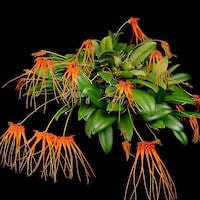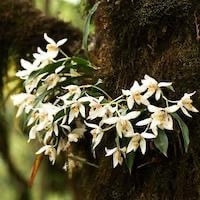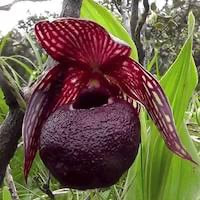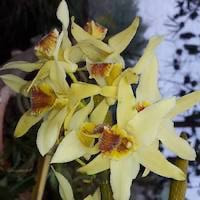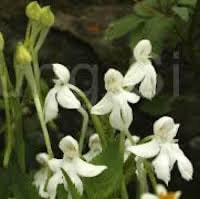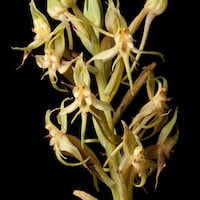MOR11- Men's Oriental 11 - The perfect man
|
Native Singaporean Orchid notes: Laeliocattleya Irene Holguin 'Brown Eyes'
Laeliocattleya Irene Holguin 'Brown Eyes' is a renowned orchid hybrid celebrated for its sweet fragrance and striking appearance, resulting from its parentage of Cattleya Astral Beauty and Cattleya J. A. Carbone. It thrives in intermediate to warm temperatures and requires medium to high light levels to bloom beautifully during spring and summer. Its medium lavender petals and sepals complement a distinctive lip that transitions from deep gold to reddish-purple, making it visually captivating. Propagated through mericlone, this orchid's fragrance inspires Oriental-themed perfume workshops, offering a luxurious and elegant aroma that encourages creativity in fragrance blending. However, crafting perfumes requires expertise and additional ingredients beyond the orchid's natural scent.
|
Therapeutic Orchid notes:
|
Bulbophyllum pectenveneris
Bulbophyllum pectenveneris, known as the Yellow Flower Folding Petal Orchid or Yellow Flower Stone Bean Orchid, is an orchid species found in parts of Asia, including China. In traditional Chinese medicine (TCM), it is believed to have medicinal properties that can improve blood circulation and alleviate joint, muscle, and bone pain. Used as an herbal remedy, its preparation and usage methods vary across regions. However, modern scientific research on its effectiveness and safety is limited, so caution is advised. Consulting a healthcare professional before using this orchid for medicinal purposes is recommended to ensure safe use and to understand potential interactions with other medications. |
|
Coelogyne occultata Hook. f. syn Pleione occulta (Hook f.) Kuntze
Coelogyne occultata, also known as Pleione occulta, is an orchid species native to parts of Asia, including Yunnan and Tibet in China. In traditional Chinese medicine (TCM), it is valued for its medicinal properties. Known as Luanyebeimu Lan or Youguashihu, it is used to nourish yin, support kidney health, enhance stomach function, and promote bodily fluids. It's employed to alleviate conditions such as hot flushes, fever, backache, anorexia, and gastritis. However, while these uses are rooted in traditional practices, scientific research on its effectiveness and safety remains limited. Consulting a healthcare professional before using Coelogyne occultata or any herbal remedy is advisable, especially to understand potential interactions with medications and individual health considerations. |
|
Cypripedium tibeticum King ex Rolfe syn. Cypripedium corrugatum Franch.
Cypripedium tibeticum, also known as Cypripedium corrugatum, is an orchid species native to Tibet and Yunnan in China. It blooms from May to August in open forests and rocky slopes. In traditional Chinese medicine (TCM), its roots are used for their anti-inflammatory and pain-relieving properties. They are believed to increase urine output, reduce painful swellings, and enhance blood circulation. Historical uses also include treating menstrual disorders. Despite its traditional uses, scientific research on its medicinal benefits remains limited. Consultation with healthcare professionals is recommended before using Cypripedium tibeticum or any herbal remedy due to potential interactions with medications and individual health conditions. |
|
Dendrobium heterocarpum Wall. ex Lindl.
Dendrobium heterocarpum, known as Jiandaochun Shihu in Chinese, is an epiphytic orchid found across Asia, from Bhutan and Nepal to Southeast Asian countries like Thailand, Malaysia, and Indonesia. It grows on trees or rocks and is admired for its colorful flowers. In traditional herbal medicine, a paste made from its stems mixed with wheat flour is applied externally to treat fractures and dislocations, believed to aid in bone healing and musculoskeletal issues. While it holds historical medicinal uses, scientific research on its benefits is limited. Consulting a healthcare professional before using Dendrobium heterocarpum or any herbal remedy is advised, considering individual health conditions and potential medication interactions. Sustainable harvesting practices are also crucial for conserving this orchid and its habitats. |
|
Habenaria longicorniculata J Graham Syn. Habenaria longecalcarata A. Rich.
Habenaria longicorniculata, also known as Devasunda in India, is a flowering orchid found in the Western Ghats, Tamil Nadu, and other regions of India. It blooms between July and November at elevations from 800 to 1900 meters. Traditional Indian herbal medicine uses the fresh tubers of this orchid to reduce scrotal enlargement and treat pain and swelling. It's also used in treating leukoderma, where a paste made from crushed tubers and turmeric powder is applied to affected skin areas. Scientific research on its medicinal benefits is limited, so consulting a healthcare professional before use is recommended, along with sustainable harvesting practices to protect its habitat. |
|
Habenaria stenopetala Lindl.
Habenaria stenopetala, known as Xiabanyufenghua in Chinese and Jishencao in Chinese medicine, is a terrestrial herb widely distributed across Asia. It thrives in open areas and dipterocarp forests at elevations from 300 to 1800 meters. This orchid species blooms from August to October in India and China and from August to September in Thailand, featuring slender stems, narrow leaves, and intricate star-shaped flowers in shades of white, cream, or green. In traditional Chinese medicine (TCM), Jishencao is esteemed for enhancing kidney and sexual functions, treating conditions like erectile dysfunction and hernias. It's crucial to consult with healthcare providers before using this herb, considering individual health conditions and ensuring sustainable harvesting practices to protect its habitat. |
Other scent note
Scentopia Library Reference ingredient
Sage - Check details at Scentopia's scent library
Download the guided mediation that works best with this Orchid fragrance oil
| men_oriental_essential_oil_orchi_00011.mp3 | |
| File Size: | 97506 kb |
| File Type: | mp3 |

